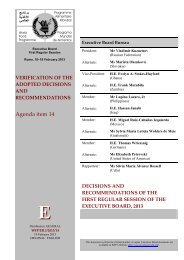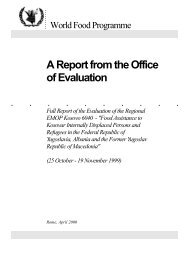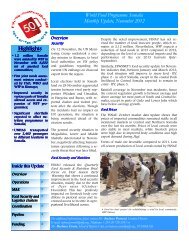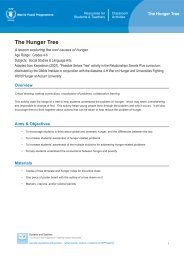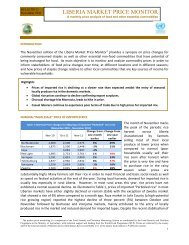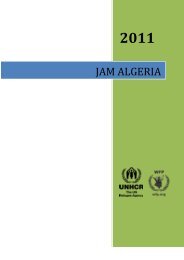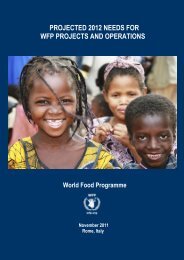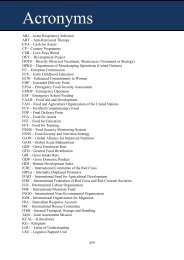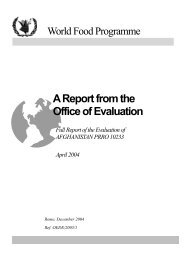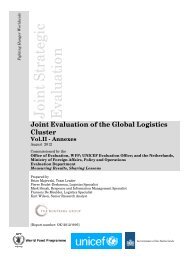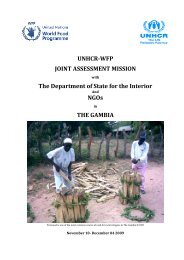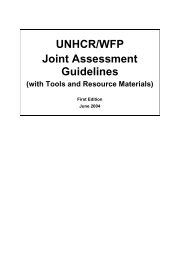Food Security Atlas of Rural Bihar - WFP Remote Access Secure ...
Food Security Atlas of Rural Bihar - WFP Remote Access Secure ...
Food Security Atlas of Rural Bihar - WFP Remote Access Secure ...
Create successful ePaper yourself
Turn your PDF publications into a flip-book with our unique Google optimized e-Paper software.
some, even substantial, impact on the access <strong>of</strong> children, girls and boys, to food. The performance<br />
<strong>of</strong> these schemes depends very substantially on demand from below for provision <strong>of</strong> these services,<br />
and also on the involvement <strong>of</strong> women in local governance. But, the entitlements that come through<br />
special interventions have been separated in our analysis from those that provide the ‘normal’<br />
entitlements to food. Of course, we also try to see whether there is a connection, as there ought to<br />
be, between the food security status <strong>of</strong> a district and the public interventions in that district.<br />
It therefore emerges that there are a number <strong>of</strong> indicators that influence food insecurity in one way<br />
or the other. We have combined these indicators into a set <strong>of</strong> three broad food security indices:<br />
1. Production factors (at the district level) influencing availability;<br />
2. Household and individual access to food; and<br />
3. Ability to absorb food.<br />
3.3.1 <strong>Food</strong> Availability<br />
The concern for food availability stems from production and related aspects that sustain a desired<br />
level <strong>of</strong> food production (Box 3.2). <strong>Food</strong>grains are considered to be <strong>of</strong> paramount significance for<br />
household food and nutritional security, the reason being that cereals and pulses are staple foods<br />
and there are no perfect substitutes for them (Chand, 2007). <strong>Food</strong>grains are also the cheapest source<br />
ANALYSIS OF FOOD SECURITY<br />
Box 3.2. Agricultural Production and <strong>Food</strong> <strong>Security</strong><br />
It is commonly believed that agricultural production directly affects food security. However, there is more to it than a mere direct<br />
link. Rising agricultural productivity increases rural incomes and lowers food prices, making food more accessible to the poor.<br />
Improving irrigational facilities and growing drought-tolerant crops reduce income variability by mitigating the impact <strong>of</strong> drought.<br />
Productivity enhancements are key to greater food security for households with limited access to food markets. Nutritionally<br />
enriched crops give access to better diets, particularly through bi<strong>of</strong>ortification that substantially improves the nutrient content <strong>of</strong><br />
the crop.<br />
Thus investments in agriculture are important to ensure food security. However, there is an increasing concern about global food<br />
security in future, largely consequent upon growing resource scarcity and climate change. In the present world, many countries<br />
have diversified their export base, and trade at large stabilizes food availability. However, food availability is still a concern in<br />
many agriculture-based countries. Many countries have declining per capita production <strong>of</strong> food staples. Further, staple crop<br />
production in most <strong>of</strong> these countries is rain-fed and experiences large fluctuations caused by climatic variability.<br />
The increase or even sustenance <strong>of</strong> the present level <strong>of</strong> production is limited by a number <strong>of</strong> factors – land constraints, water<br />
scarcity, high energy prices – along with the uncertain effects <strong>of</strong> climate change, which has been considered to be one <strong>of</strong> the<br />
areas <strong>of</strong> greatest uncertainties for agriculture. The combined effects <strong>of</strong> higher average temperatures, greater variability <strong>of</strong><br />
temperature and precipitation, more frequent and intense droughts and floods and reduced availability <strong>of</strong> water for irrigation can<br />
be devastating for agriculture, particularly in the tropical regions. It has been predicted that agricultural GDP in Sub-Saharan<br />
Africa could contract by anywhere from 2 to 9 per cent.<br />
Source: World Development Report, 2008.<br />
31



